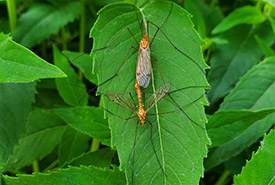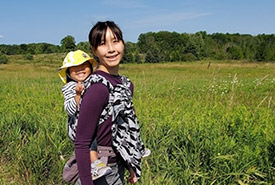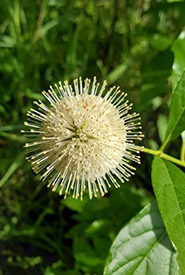NCC: Land Lines – Hey [name I don’t yet know], mind if I take a picture of you?

Two crane flies on a wild bergamot leaf (Photo by Wendy Ho/NCC staff)
The other week while checking out the wild bergamot in my backyard for powdery mildew, I noticed a big insect perching motionless on the plant’s long serrated leaf. I thought it was a giant daddy long-legs (aka cellar spider). Upon closer look, I found that this “insect” was actually two individuals locked together, tail to tail. I snapped a photo and asked around what it could be. I’ve since learned that they’re crane flies, a type of insect that likes moist habitats with larvae that feed on decomposing vegetation.
I picked up this habit of recording interesting finds in nature on my phone from participating in the Nature Conservancy of Canada’s (NCC’s) Big Backyard BioBlitz last year. A bioblitz is a volunteering effort to document as many species as possible during a set time.
Whether it’s a familiar species or not, it’s worth taking a moment to snap a picture or record a sound. During the bioblitz, I noticed that I intentionally slowed down to notice the colours, shapes and features from different angles. Doing so helped me deepen my appreciation for other species. I also love the endless educational opportunities. The more we know about the nature that surrounds us, the more we can support it and in doing so, support the wellness of our communities. Sharing my observations with others also sparked curiosity and conversation.
You can contribute to science
By documenting plants, animals and even fungi, you contribute to the collective knowledge about species in your local community, and your observations may support scientific research.
Learn how to get good photos for species identification
How does recording a bird or insect help contribute to science? Well, the power of this collective volunteer effort is in the large amount of species observations recorded and knowing where they were spotted. Photographs or sound clips become data that can be used by conservationists to target areas for protecting species at risk or eradicating invasive species.
If contributing to science excites you, you can learn more about how nature enthusiasts are doing just that. Check out my colleague Sarah Ludlow’s her blog about volunteer-powered science and data collection.
Or better yet, you can join me and thousands of participants across the country in this year’s Big Backyard BioBlitz.
In last year’s Big Backyard BioBlitz, participants young and old, new and experienced, recorded more than 35,000 nature observations and made more than 4,200 unique species observations. Some participants spotted species at risk in and around urban centres. I may not be a scientist myself but contributing to science excites me, and that’s why I’ll be participating again this year with my family.
Check out some of the observations that bioblitz participants submitted last year:
Involve the kids and you’ll be surprised what they find

My younger daughter and I during the 2021 Big Backyard BioBlitz weekend (Photo courtesy of Wendy Ho/NCC staff)
During last year’s Big Backyard BioBlitz and as a parent of two young kids, I was caught between keeping an eye on my kids on the path while stopping to snap that close-up photo of a plant or insect. With my younger one, using a carrier was helpful when I wanted to do some serious bioblitzing.
The carrier kept her safe and gave me the freedom to use both hands for photography. I rambled on to her about any observations to quell her desire to keep moving on the trail. But I think she enjoyed the higher vantage point most of all and having me as a captive audience for her questions.
BioBlitz: A fun event for all ages

Céphalanthe occidental. Mon adorable fille de deux ans m’a demandé si c’était le virus de la COVID-19 (Photo de Wendy Ho/CNC)
Now, although this can be important for science and conservation, don’t forget to have fun in the process. Maybe a friendly competition between friends, go for the leaderboard title, or just record as much as your time and energy allows.
This year, I hope that my kids will be my beacon for interesting species observations from their one-metre height level. We look forward to another memorable summer activity and hope to create a family tradition in nature.
Every observation counts. Mark the dates July 28 to August 1 and sign up for the Big Backyard BioBlitz this summer.




